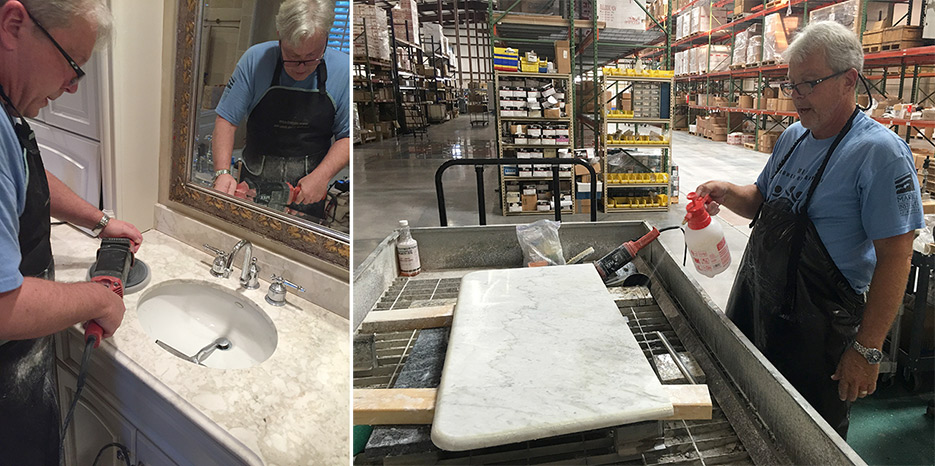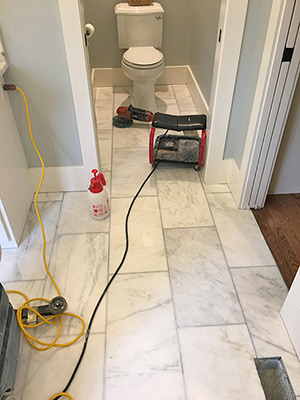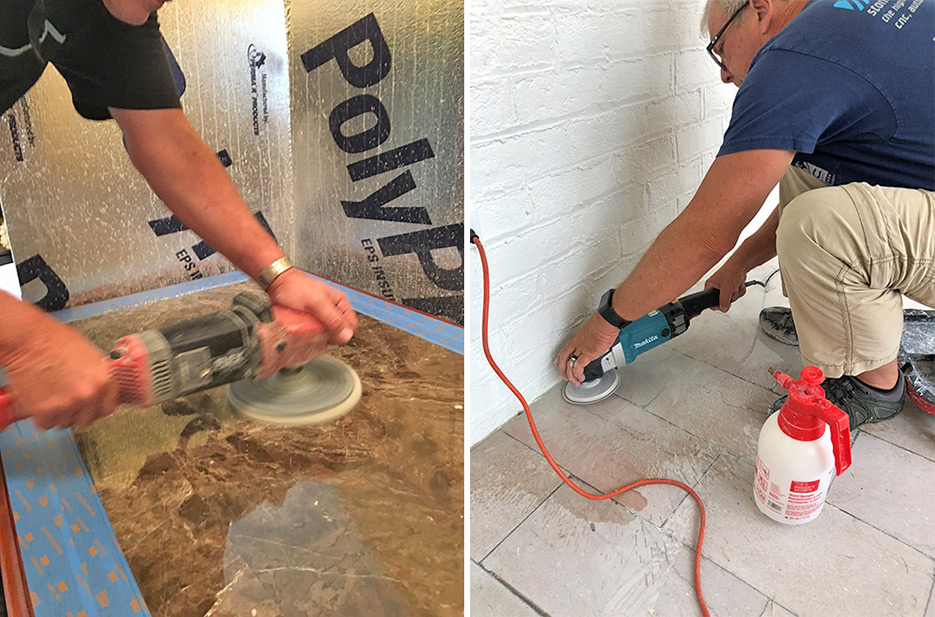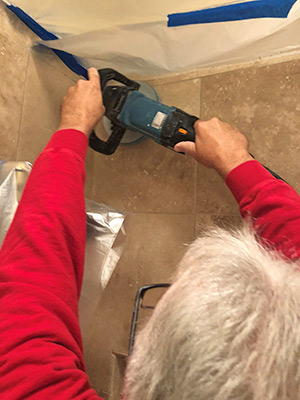Stone Restoration and Maintenance Corner – Hand Tools Revisited
Bob Murrell
M3 Technologies
Photos by Bob Murrell
Quite frequently, the hardest part of most any stone restoration project is the hand tool work. Doing the edge work on a floor is certainly an arduous task. And, in many cases, the most experienced person on the project is the one who must do it, so that it gets done right. This gets even more complicated when there is lippage that requires removal and or the stone is black or dark-colored. It is essential that the floor blends well with the edges.
Doing countertops successfully also requires an experienced technician. When honing with diamonds, being only a few degrees off angle of the surface can cause the countertop to end up with a distinctive circular scratch pattern. Of course, these scratches must be rectified, before the top can be completed. Unfortunately, when the unwanted scratch pattern becomes visible is after you have finished the final polishing step.
 |
|
Above, left: Adding finishing touches on a marble vanity using an older Flex 302. Above, right: Here I’m using a small pump-up sprayer as the water source for refinishing an antique marble vanity top. |
 |
|
This is my typical setup for doing edge work. Notice the mechanic’s “creeper” |
Now that we have addressed how difficult using a hand tool properly can be, let’s throw in using a hand tool on a vertical surface, like a shower wall. Hopefully, honing with diamond discs will not be required for your vertical project, although I have seen it be necessary many times. Keeping the diamond disc flat on the surface to avoid the unwanted honing scratch pattern can be quite difficult, and what’s worse, the operator fatigues quickly in this scenario.
There are many issues when working with a hand tool, such as water supply and management. I like to use a small garden pump-up sprayer – one that is bigger than a regular spray bottle, but not too heavy, either. Pump-up sprayers also release water continuously when well-pumped (pressurized). I have used a steady water supply (spigot and garden hose) when more water is necessary, like for a center water-feed (through-the-spindle) tool. Center water-feed tools need the water or the seals may burn up. Safety tip: never operate a through-the-spindle water-fed tool dry!
Of course, when you are using water, this can create quite a mess, so proper masking and draping of surrounding areas becomes necessary. I suggest that everyone get some 4 foot x 8 foot sections of foam board insulation. I take the 4 x 8 sheet and score it (just cut the skin) so that it will fold to about a 140 (degree) angle and will stand on its own. Once scored, use red polyvinyl tape to secure the scored area. Use these foldable sheets to protect adjacent areas when doing counter tops, tables, and vanities. They can be easily hosed down at the end of the day and will last quite a while.
You will also need to use “Tape & Drape“ masking plastic for cabinets and other adjacent areas that will need both water and chemical protection. You will also need blue painter’s tape and the red polyvinyl tape for additional protection and securing of plastic Tape & Drape.
 |
|
Above, left: Refinishing a table top on site, and using foam board insulation walls and blue tape to protect the surrounding area. Above, right: Lippage work on Tennessee Pink marble using an ELF Flexible Metal mounted on a Makita grinder. |
 |
|
Using my Makita grinder to do tough work on a shower stall vertical surface. The “D” handle helps me maintain good control. |
An extension cord will be necessary for most hand tool operations. Be sure to use one that is water resistant and also of ample gauge (diameter of wire) so as not to cause too much amperage draw on the hand tool. Excessive heating of the hand tool motor will result from using an insufficiently-sized extension cord. Overheating will ultimately shorten the life of the motor. The longer the extension cord, the bigger the gauge the cord needs to be. I would say a 25-foot cord should be at least a 14 gauge. If you need an extension cord longer than 50 feet, then you should probably be looking at a 12 gauge wire. If you feel your machine getting hot, turn it off immediately and check the extension cord size and all connections.
There are many accessories available for your hand tool, provided that the machine has features standard to our industry. The tool needs to have a spindle that is 5/8-inch diameter with 11 threads per inch (commonly called 5/8˝ x 11). This size spindle is what the industry and all of the stone restoration products supply companies, like M3 Technologies and BB Industries, is geared for. Pretty much all of the accessories like pad drivers, Velcro diamond drivers, core bits, diamond cup wheels and many other tool set-ups are all designed around the 5/8˝ x 11 spindle. There are a few exceptions like a 20mm spindle, but I prefer to stay with the 5/8˝ x 11.
In the stone restoration industry, we mostly use slow speed operation, so your machine will need to be able to go below 1,000 rpm and preferably down to at least 600 rpm. Remember, you will be slinging water and slurry everywhere. Also, with faster rpms (1,000 rpm and higher), you would definitely need a center water-feed tool to keep the diamond properly lubricated and clean. Polishing with 5X and other powders or compounds is a slow speed operation, period. Diamonds can be run slow or somewhat faster, but you must be able to keep the water flowing under the diamond while in use.
I have sold many brands of hand tool machines through the years. I’ve always liked Flex, Makita, Fein, and Metabo, which are all industry standards. I like my Makita 9237 CX3 but have also had to run out to a box store and pick up a Dewalt, which still runs pretty good to this day. If you’re going to use your tool for anything that may require the best motor strength, like a custom planetary driver, I would stick to the Flex or Makita, for sure.
These are many of the issues with hand tool use. Remember, running a hand tool is exhausting, especially doing edge work. Plan and price accordingly for all hand tool work. Don’t be that contractor who gets beat up on costs at the end, because of the unaccounted for additional labor and product expended doing the hand tool work the right way.
As always and before beginning any new project, I recommend submitting a test area to confirm the results and the procedure, prior to starting a stone or hard surface restoration/maintenance project. Also, the best way to help ensure success is by partnering with a good distributor, like BB Industries, that knows the business. They can help with technical support, product purchase decisions, logistics, and other pertinent project information.
Bob Murrell has worked in the natural stone industry for over 40 years and is well known for his expertise in natural stone, tile, and decorative concrete restoration and maintenance. He helped develop some of the main products and processes which revolutionized the industry, and is currently the Director of Operations for M3 Technologies.
Send your comments and questions to Bob at attn:publisher@slipperyrockgazette.net .